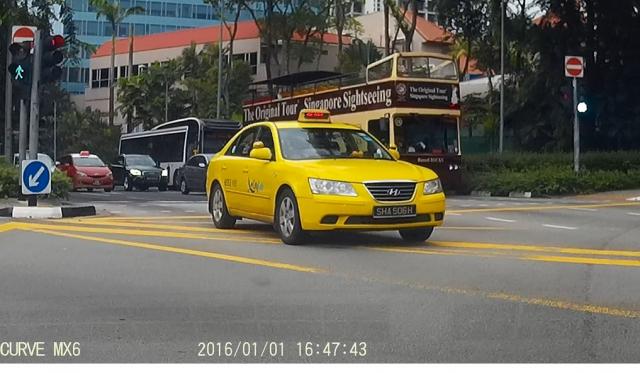Search the Community
Showing results for tags 'cab'.
-

Taxi driver tries to pick a fight after driver behind refuses to give way!
chitchatboy posted a blog entry in MyAutoBlog
Have you encountered trouble at carpark entries and realised that you needed to have another go with the IU scanner but the car behind is so close that you cant even reverse a tiny bit? We sure have and know how troublesome it is get the car behind to reverse so that you can re do the IU scan. Often, the driver behind refuses to bulge leaving you in an awkward position and frustrated at the driver behind you. Something like this happened on 22nd of October 2020 at Crawford Court between a Prius Trans-Cab and an unknown camera car. However, egos and tempers got the best of them and things turned out ugly. Who was in the wrong? Watch the video as posted by SG Road Vigilante and let us know in the comments below! -
HDT Singapore Taxi second cab company equipped to respond to cardiac arrests source: https://www.straitstimes.com/singapore/hdt-singapore-taxi-second-cab-company-equipped-to-respond-to-cardiac-arrests-and-fire SINGAPORE - HDT Singapore Taxi has become the second cab company to be equipped with automated external defibrillators (AED) that can be used in emergencies like cardiac arrests. Sponsorship from the Singapore Heart Foundation (SHF) has allowed the firm to fit 50 of its electric-powered taxis with the portable device, which can send an electric shock to the heart to revive it during a cardiac arrest. The cabs are also equipped with fire extinguishers and first aid kits. Cabbies driving these taxis have been trained in life-saving skills such as cardiopulmonary resuscitation (CPR) and AED procedures, basic first aid and firefighting. The HDT Singapore Taxi - Singapore Heart Foundation AED-on-Wheels programme was launched on Monday (Nov 18) at Kampung Admiralty. The programme itself started in November 2015, when 100 SMRT taxis were equipped with AEDs. Mr Amrin Amin, Senior Parliamentary Secretary for Health and Home Affairs, said the move increases the pool of community first responders who would be "called upon to render assistance to others during emergencies". He cited the SMRT take-up of the initiative, adding: "In the event of a cardiac arrest emergency, these SMRT taxi drivers can help to deliver the AED to the scene quickly, administer the AED or perform CPR. This improves the chances of survival for the victim." The programme aims to buy time for those who suffer a heart attack, before Singapore Civil Defence Force (SCDF) officers show up. Participating cabbies will be alerted by the SCDF myResponder app to a cardiac arrest incident within a 1.5km radius of their taxi location. SMRT taxi drivers had arrived on scene to assist in 149 cardiac arrest cases as at September this year. HDT's senior manager of operations, Mr Leslie Ng, said if a taxi has a passenger on board when an alert comes in, the driver will state that he is diverting to the incident. Singapore Heart Foundation chairman Tan Huay Cheem said at the launch that there are around 1,800 cardiac arrest cases a year with 60 per cent involving mainly the elderly at home but that number may increase over time. He said: "Heart attack is the main cause of cardiac arrest and an aging population naturally brings about a higher number of such incidents. So by making the AED available and accessible in all channels, we hope that every life can be saved." HDT was set up here in 2016, and is Singapore's seventh taxi operator. It has around 120 drivers, all of whom have completed over 80 hours of training such as the SkillsFuture for Digital Workplace programme and courses for handling children and passengers with special needs. Singapore's largest taxi operator is ComfortDelGro, which operates about 11,500 Comfort and CityCab taxis. ComfortDelGro chief spokesman Tammy Tan told The Straits Times that the firm is "exploring the idea" of equipping its vehicles with AEDs.
-

A woman being a PUBIC nuisance on Middle Road. No, that's not a typo
jameskarlchan posted a blog entry in MyAutoBlog
You probably have seen a video that went viral recently about a woman removing her clothes in anger on Middle Road. She even went as far as pulling down her panties! If you haven’t, here’s the video courtesy of Roads.sg In the video, you can see a woman taking off her clothes in response to a man (a cab driver) walking away from her. She is believed to have done this to play the victim card and make false accusations that the cab driver was the one who did it to her. Crucial eye witness account An eye witness of the incident posted the video on Roads.sg According to the witness, he saw the lady kicking the cab. She then began chasing the cab driver, scratching, punching and going all bat shit crazy. The driver did not retaliate to her provocation. So what triggered this? There have been no reports (as of yet) as to what led to this behaviour, but theories are being thrown around on social media. Even I would be offended. At least give me $10 What happened in the end In a recent STOMP article posted earlier today, it’s been confirmed that the lady, a 31-year old woman was arrested for PUBLIC nuisance. Yeap, I spelt that one right. You can read the full article here Header image by STOMP- 4 comments
-
On a private car, this would count as an illegal modification. OK for taxis coz LTA gets a fee for the ad?
-
I was on my way to watch Ip Man 3 at Shaw Centre on 1st Jan at around 445pm. Was waiting at the junction of Scotts Road and Stevens Road/Draycott Road to turn right to park my car at Shaw Centre. When the light turned green, there was this City Cab driver who beat the red light and I almost got into accident with him. I won't upload the video as I am having issues with my video editing software, but I suppose the 3 pics are sufficient to illustrate and the 3rd picture shows the light is green in my favour. It gave me a fright but it didn't stop me from enjoying Donnie Yen wing chun moves. =))
- 31 replies
-
- volkswagen
- red light
- (and 4 more)
-
I start the 1st, https://www.youtube.com/watch?v=jZvr1tul8QY&feature=youtu.be
-
COMMUTERS who are already bewildered by Singapore's extensive range of taxis and their varied and complex fares will soon have to contend with more confusion. Thanks to new-age transport service providers, such as Uber and GrabTaxi, unmarked vehicles with no meter but offering taxi-like services are entering the cab sphere. Confusion, however, may not be their only concern. Some of these vehicles may not have the authorities' approval for paid passenger services. Should something go wrong, like an accident, the commuter may not have legal recourse. Neither would he be covered by insurance. Some commuters are already expressing unease, saying they would prefer to stick to clearly-marked cabs. Singapore is not alone in grappling with the potential pitfalls of this new technology. Several cities are facing the same situation. Last Friday, Sydney, in Australia, launched a probe into ride-sharing app developer Uber. Its government warned drivers against using their private cars to offer paid rides. Dallas, in Texas, is proposing new regulations to govern these emerging "quasi-taxi" services. Shanghai and Beijing, cities in China, have cracked down on a number of taxi apps that have sprouted. Will these new-tech transport applications fizzle or stay? Are they a boon or bane? For the first question, the current consensus is they are quite likely to stay - and thrive. For the second, it depends on who is asking. The apps will definitely lead to stiffer competition for taxi operators, which are likely to see immediate erosion to their phone-booking revenue. The apps also translate to more choices for cabbies and other driving professionals. The heightened competition could persuade taxi companies to reduce what they charge cabbies for each phone booking. That is good for cabbies. But what about commuters? Will the apps improve taxi availability? Not necessarily. As more cabbies cater to phone- or apps-based demand, commuters will find it more difficult to hail a cab on the road. In fact, this may be one of the reasons Shanghai and Beijing cracked down on taxi apps. It was becoming harder for people to hail a cab from the kerbside. Commuters in Singapore are familiar with this phenomenon. During peak hours, only those willing to book via the phone have always been the likeliest to get a cab. The only upside for commuters would be the possibility of phone-booking charges falling in light of heightened competition from the apps. Still, the apps are on the whole probably more positive for cabbies than for commuters. What about regulators? Should they ponder on whether these apps and their related services would lead to a laissez-faire environment reminiscent of the pre-1970s "pirate taxi" days? The Land Transport Authority at present seems to be taking a light-handed approach. But let's hope it remains vigilant and that it will act swiftly to stamp out practices that may compromise the safety of commuters or the reputation of the state. From a big picture perspective, the new apps may increase efficiency, with fewer taxis plying in search of passengers. This should lead to less pollution, less congestion and lower energy use. In short, all the ills of empty cruising. by Christopher Tan
- 3 comments
-
- taxi booking
- booking app
- (and 6 more)
-
http://www.youtube.com/watch?v=HP18VqvsJWM A drunk driver tried to flee after running over a motorcyclist in Korea, only to be chased down and trapped by a cabby and Porsche driver. According to a Korea Bang article, Ms Wu had been speeding in the far left lane, when she hit a biker at the traffic light. The scene was witnessed by Choi the Porsche driver and Ahn the cabby, who immediately went after Ms Wu as she tried to leave. The pursuit went on for minutes as Ms Wu continued driving recklessly in an attempt to shake off the two drivers. Together, they finally closed in on her vehicle and blocked the path. Ahn and Choi were each awarded 200,000, 40 bonus driving points, together with a letter of appreciation by the Western Daejon Police Department. The motorcyclist was discharged from hospital with no serious injuries, while Ms Wu was fined. Source: http://singaporeseen.stomp.com.sg/singaporeseen/get-inspired/cabby-and-porsche-driver-team-up-to-chase-down-drunk-female-driver-who-ran-over-biker#.UqAKD31nsBA.facebook Respect the Porsche and cabby who went all the way out to nab the female driver. If this was in Singapore, probably will be reprimanded by TP, and awarded demerit points. No such thing as bonus driving points.
- 37 replies
-
- 4
-

-
- porsche
- hit and run
-
(and 2 more)
Tagged with:
-
There are some 30 types of cabs in Singapore, in at least eight different colours, across seven brands. If that is not enough to make commuters dizzy, there are close to 10 different flagdown fares, three different metered fare structures, more than 10 different types of surcharges, and eight types of phone booking charges. Mix and match each of these types of charges to the various types of taxis and you will get combinations that rival the Rubik's Cube in complexity. Marketing professional and regular taxi customer Lau Sau Kuen probably echoed the sentiment of other commuters when she said: "It's terrible we have so many types of cabs and so many different rates. I don't know the rates any more. Just as I don't know the different surcharges any more. I'm resigned to paying whatever the cabby tells me to at the end of a ride." And if locals like Ms Lau find it confusing, what chance do visitors have? It does not help one bit that operators are now allowed to adjust fares at will. So, even if you managed to memorise the dizzying permutations of fares, you would need to be eagle-eyed to spot the perpetual changes. How did Singapore come to this state? Well, it started in 1998, when taxi fares were deregulated. The Land Transport Authority said then that the move was to allow taxi companies "to set fare structures based on their assessments of prevailing market conditions". If that argument is sound, why don't we allow bus and train operators to do likewise? Why are there two fundamentally different policies for taxis and other forms of public transport? This approach does not stand up to scrutiny - unless taxis are not viewed as public transport in the first place. Here, the authorities are rather inconsistent. Taxis are considered public transport when it comes to the tallying of public transport ridership numbers. Operators are given special dispensation when it comes to Certificate of Entitlement bidding, and granted bigger tax rebates than private car buyers are if they choose environmentally friendlier models. But elsewhere, they are deemed private transport. Operators enjoy a laissez-faire environment no different from that of car rental companies (in fact, they operate like car rental companies), free to set whatever rates they choose. This became more apparent when the Government liberalised the industry in 2002, a move that saw several new players entering the fray. The move resulted in a more competitive market that proved beneficial to cabbies in terms of more employment choices and attractive terms, but left a question mark over service standards - despite an almost 50 per cent surge in cab population from 2002 to last year. With about 28,000 taxis on the road, Singapore has a higher cab-to-resident ratio than most developed cities. Despite that, frequent complaints of "can't get a cab when you need one" recur. To be fair, it would be tough to get a cab anywhere in the world sometimes, such as on Saturday nights and rainy days. But macro figures suggest that taxi usage here is less than optimal. Hong Kong's 18,000 taxis make about one million trips per day. Singapore's 28,000 cabs do slightly under a million trips. On fares, Hong Kong also seems to have a more efficient system. Its cab fares are government-regulated. The market is tightly controlled too, with no new taxi licence issued since 1994. Taxis are instantly recognisable, with three basic colour schemes (red being the most prevalent). The fare structure is a lot less complex. The flagdown rate is a uniform HK$20 (S$3.20), with every 200m or one minute of waiting time charged at HK$1.50. Surcharges are few and low. For instance, phone booking is HK$5 (S$0.80), but many taxi operators will waive this. A 10km cab ride in Hong Kong costs slightly more than a ride in a normal taxi in Singapore without surcharges and booking. But with surcharges or booking, the ride here costs more - with one in a newer or fancier cab being even more expensive. Costs aside, commuters in Hong Kong seem better served than those in Singapore, as many visitors will attest. In Singapore, the Government recently put in place new measures to force taxi operators to improve service levels, especially in taxi availability, for example by imposing a minimum mileage a day. Whether that will work remains to be seen, but at least one taxi company - Premier - is reacting in a somewhat perverse way to regulations. It has jacked up its peak-hour booking charge to $4.50, compared with $3.30 charged by most others. It did so ostensibly to manage demand. With fewer people dialling for its cabs because of the revised charges, observers said Premier will be better able to meet the Land Transport Authority's (LTA) requirement for taxi operators to dispatch cabs to at least 92per cent of the people who call in. As for the mind-boggling fare structure that vexes commuters, the LTA says that companies are required to publish fare changes. Publishing fares is of no help when there are so many rates to remember. And because of the exigent nature of transport, consumers are less in a position to pick and choose taxis even if they recall rates - unlike the situation they face when shopping for groceries or going for a haircut. Is it then time for the Government to re-regulate fares and the industry? Indeed, it must. If it considers taxis as public transport. Photo Credit: ST FILE PHOTO






